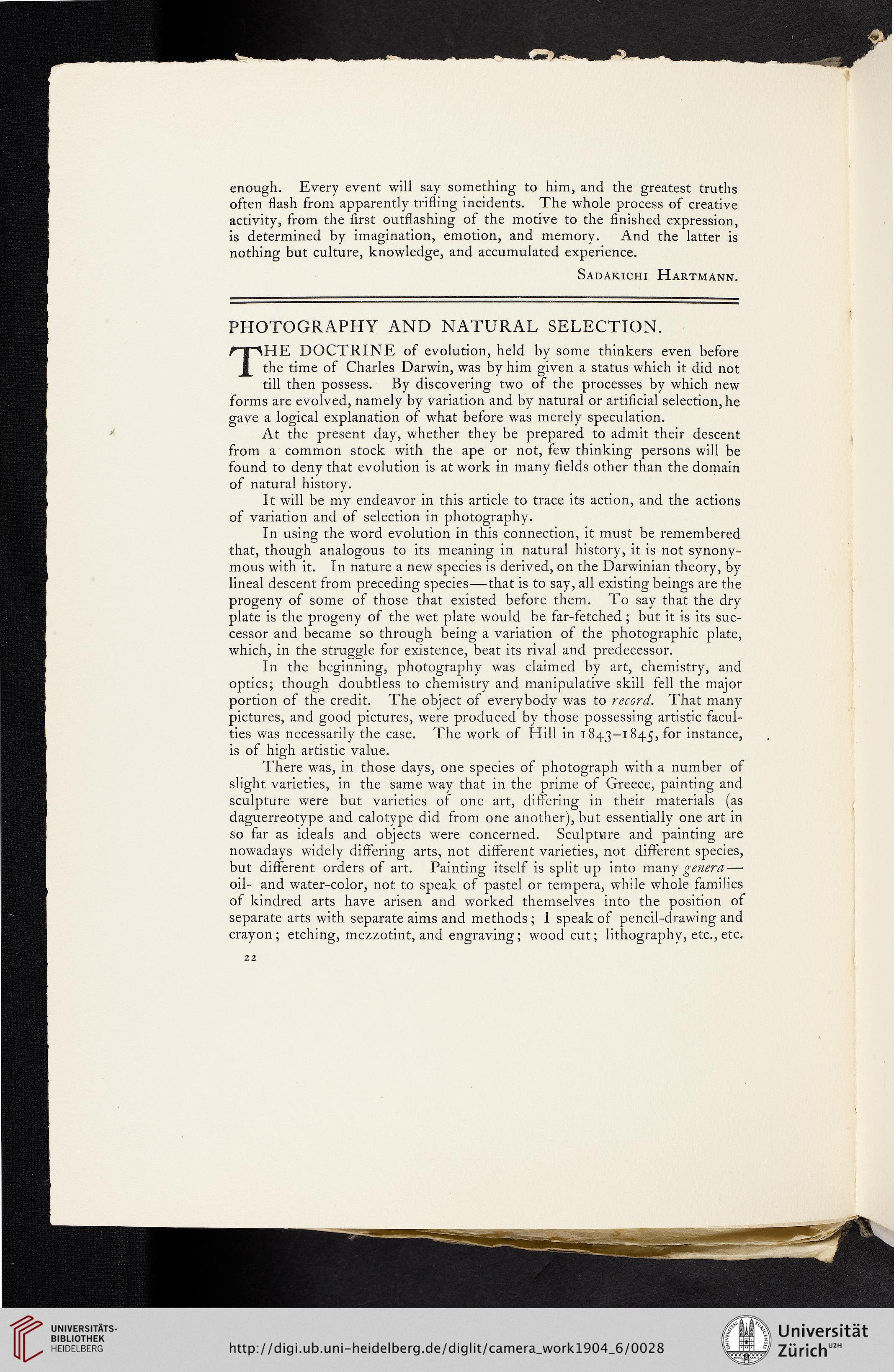Für diese Seite ist auch eine manuell angefertigte Transkription bzw. Edition verfügbar. Bitte wechseln Sie dafür zum Reiter "Transkription" oder "Edition".
enough. Every event will say something to him, and the greatest truths
often flash from apparently trifling incidents. The whole process of creative
activity, from the first outflashing of the motive to the finished expression,
is determined by imagination, emotion, and memory. And the latter is
nothing but culture, knowledge, and accumulated experience.
Sadakichi Hartmann.
PHOTOGRAPHY AND NATURAL SELECTION.
THE DOCTRINE of evolution, held by some thinkers even before
the time of Charles Darwin, was by him given a status which it did not
till then possess. By discovering two of the processes by which new
forms are evolved, namely by variation and by natural or artificial selection, he
gave a logical explanation of what before was merely speculation.
At the present day, whether they be prepared to admit their descent
from a common stock with the ape or not, few thinking persons will be
found to deny that evolution is at work in many fields other than the domain
of natural history.
It will be my endeavor in this article to trace its action, and the actions
of variation and of selection in photography.
In using the word evolution in this connection, it must be remembered
that, though analogous to its meaning in natural history, it is not synony-
mous with it. In nature a new species is derived, on the Darwinian theory, by
lineal descent from preceding species—that is to say, all existing beings are the
progeny of some of those that existed before them. To say that the dry
plate is the progeny of the wet plate would be far-fetched ; but it is its suc-
cessor and became so through being a variation of the photographic plate,
which, in the struggle for existence, beat its rival and predecessor.
In the beginning, photography was claimed by art, chemistry, and
optics; though doubtless to chemistry and manipulative skill fell the major
portion of the credit. The object of everybody was to record. That many
pictures, and good pictures, were produced by those possessing artistic facul-
ties was necessarily the case. The work of Hill in 1843-1845, for instance,
is of high artistic value.
There was, in those days, one species of photograph with a number of
slight varieties, in the same way that in the prime of Greece, painting and
sculpture were but varieties of one art, differing in their materials (as
daguerreotype and calotype did from one another), but essentially one art in
so far as ideals and objects were concerned. Sculpture and painting are
nowadays widely differing arts, not different varieties, not different species,
but different orders of art. Painting itself is split up into many genera —
oil- and water-color, not to speak of pastel or tempera, while whole families
of kindred arts have arisen and worked themselves into the position of
separate arts with separate aims and methods ; I speak of pencil-drawing and
crayon; etching, mezzotint, and engraving; wood cut; lithography, etc., etc.
22
often flash from apparently trifling incidents. The whole process of creative
activity, from the first outflashing of the motive to the finished expression,
is determined by imagination, emotion, and memory. And the latter is
nothing but culture, knowledge, and accumulated experience.
Sadakichi Hartmann.
PHOTOGRAPHY AND NATURAL SELECTION.
THE DOCTRINE of evolution, held by some thinkers even before
the time of Charles Darwin, was by him given a status which it did not
till then possess. By discovering two of the processes by which new
forms are evolved, namely by variation and by natural or artificial selection, he
gave a logical explanation of what before was merely speculation.
At the present day, whether they be prepared to admit their descent
from a common stock with the ape or not, few thinking persons will be
found to deny that evolution is at work in many fields other than the domain
of natural history.
It will be my endeavor in this article to trace its action, and the actions
of variation and of selection in photography.
In using the word evolution in this connection, it must be remembered
that, though analogous to its meaning in natural history, it is not synony-
mous with it. In nature a new species is derived, on the Darwinian theory, by
lineal descent from preceding species—that is to say, all existing beings are the
progeny of some of those that existed before them. To say that the dry
plate is the progeny of the wet plate would be far-fetched ; but it is its suc-
cessor and became so through being a variation of the photographic plate,
which, in the struggle for existence, beat its rival and predecessor.
In the beginning, photography was claimed by art, chemistry, and
optics; though doubtless to chemistry and manipulative skill fell the major
portion of the credit. The object of everybody was to record. That many
pictures, and good pictures, were produced by those possessing artistic facul-
ties was necessarily the case. The work of Hill in 1843-1845, for instance,
is of high artistic value.
There was, in those days, one species of photograph with a number of
slight varieties, in the same way that in the prime of Greece, painting and
sculpture were but varieties of one art, differing in their materials (as
daguerreotype and calotype did from one another), but essentially one art in
so far as ideals and objects were concerned. Sculpture and painting are
nowadays widely differing arts, not different varieties, not different species,
but different orders of art. Painting itself is split up into many genera —
oil- and water-color, not to speak of pastel or tempera, while whole families
of kindred arts have arisen and worked themselves into the position of
separate arts with separate aims and methods ; I speak of pencil-drawing and
crayon; etching, mezzotint, and engraving; wood cut; lithography, etc., etc.
22


